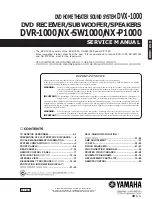
15
Four keys operate the device - Menu, Enter,
Up and Down.
Menu/ Esc:
This key accesses the controller’s menu structure
and exits a menu level.
Enter:
This key confirm changes and access menu levels.
Up and Down:
These keys navigate within a menu level and
increase and decrease displayed values. Please refer
to the menu structure quick guide at the end of the
chapter to learn more.
3.1 Level
You can adjust input levels from – 96 dB to +6 dB in
0.5 dB steps. Use the Up or Down keys to select the
gain setting and confirm your selection with Enter.
Note: The Level parameter adjusts the level after the
analog-to-digital converter to balance out varying
(system) levels. Level does not influence the input
signal’s volume in front of the analog-to-digital
converter. If the display reads “Digital Clip ?! Check
Input !” be sure to reduce the level at the mixing
console. In this case, the signal is saturating the
analog-to-digital converter, distorting the signal’s
rectangular waveform to create square waves. This
sounds extremely annoying and will eventually
destroy the power amp and speakers.
Tip: If you wish to reduce the volume of the lower
mid/high unit in the array – say, because it hangs
low and listeners are close to this unit – you can
use Level to do this. However, Level also affects the
subwoofer’s volume. Increase Sub Level by the same
value to compensate for the difference.
D. The ConTour Array™ DDO-Pro™ Controller
Fig. 16: DDO-Pro™ network
Fig. 17: DDO-Pro™ Controller panel
Net Ports link several CTA 118 Subs in a
communication network. Use CAT 5 network cables
or professional Ethercon cables with a metal plug
to do this. Connect the first CTA 118 Sub’s output to
the next unit’s input, and so forth.
Note: This is purely a data interface. The DDO-Pro™
Net Port does not send audio signals.
If you wish to adjust controller settings (for example,
filter, gain or delay), you can do this on any CTA 118
Sub’s control panel. Automatically, the unit becomes
the master controller and sends parameter changes
to all networked CTA 118 Subs (up to 32 units).
Note: It does not send "Utilities" menu settings.
Caution: If you wish to use another CTA 118 Sub and
a ConTour Series™ cabinet (CT 108, CT 112, CT 115) for
near-fill or in-fill applications alongside CTA 208
speakers in a larger rig, DO NOT network it! Otherwise
the connected CT 108, CT 112 or CT 115 will adopt the
settings entered for the mid/high array.
2. Audio Signal Routing
Use an XLR cord to connect the signal source to
the first CTA 118 Sub’s signal input. If you wish to
connect further CTA 118 Subs to the source, do this
using the Signal Through ports. The XLR port’s pin
assignments are: pin 1 = ground, 2=+, 3=–.
Be sure to read section 3.1 covering maximum input
signal level and digital clip error and heed these
guidelines.
1. The DDO-Pro™
Net Port
CTA 118 SUB
CTA 118 SUB
CTA 118 SUB
CTA 118 SUB
The AD converter’s Digital Clip indicator
En
g
li
sh
3. Handling the
DDO-Pro™ Controller





































